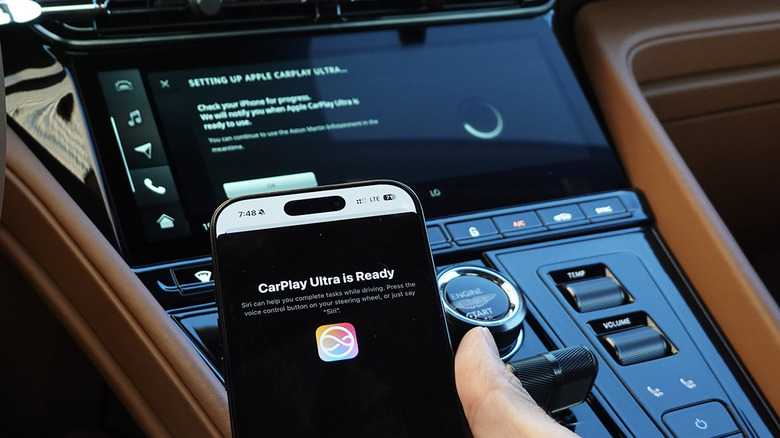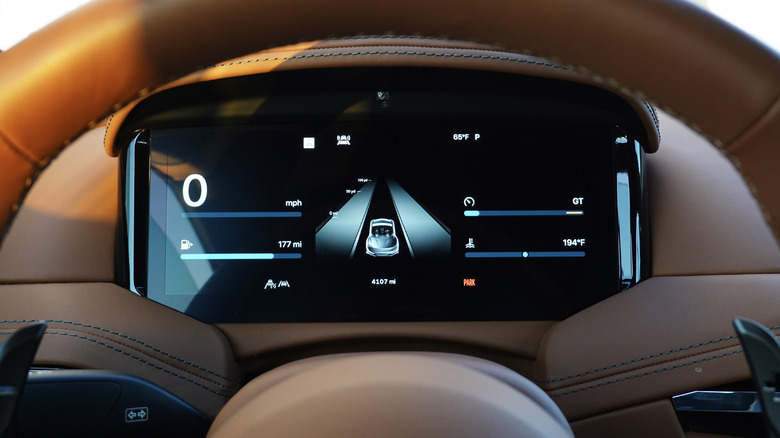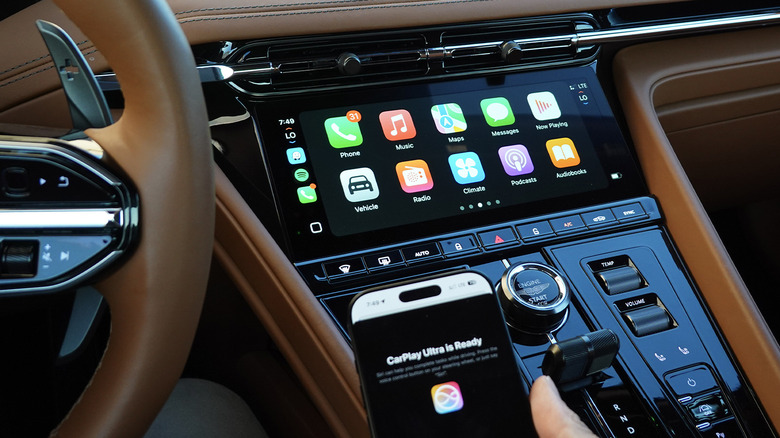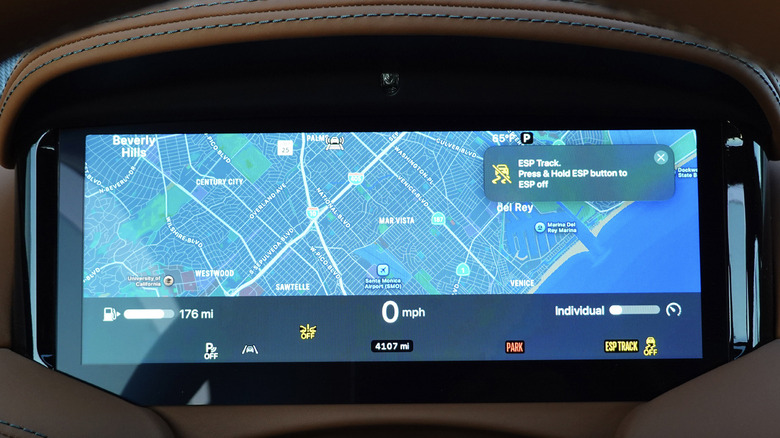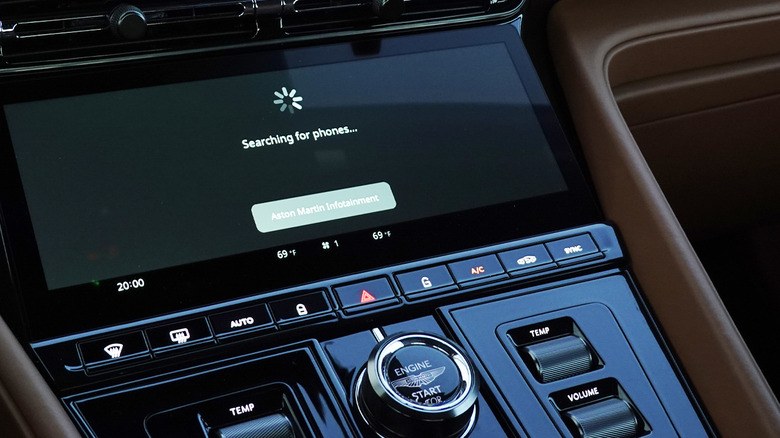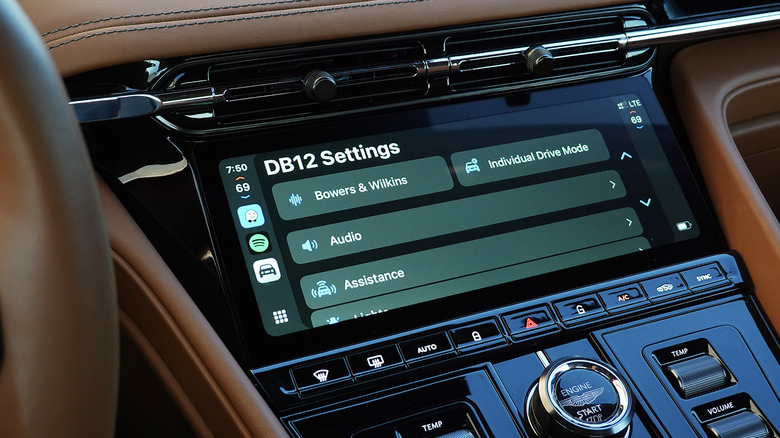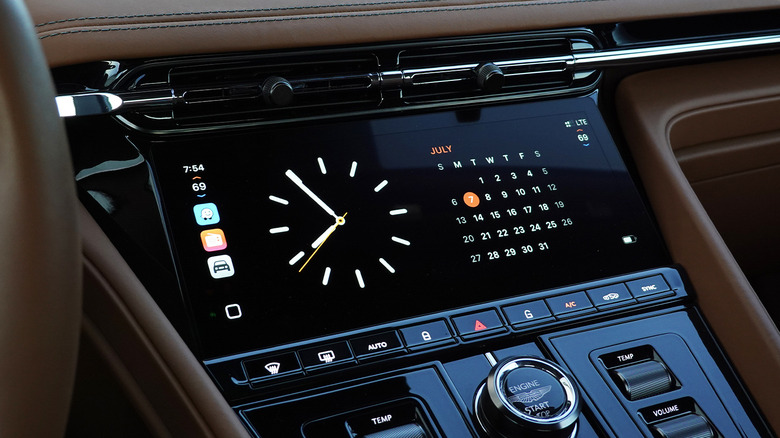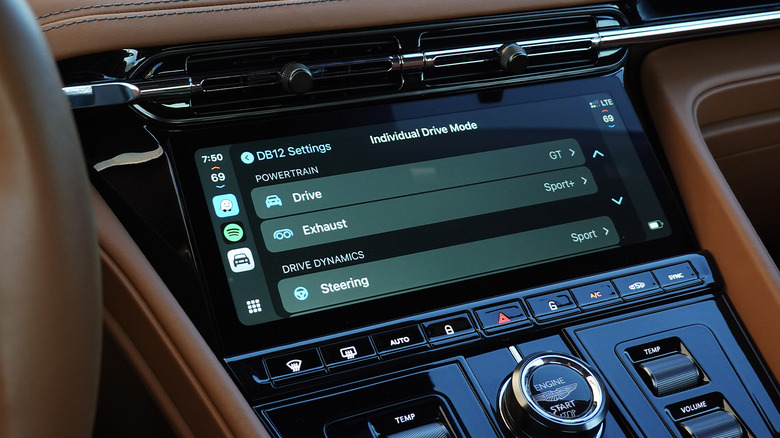I Tested Apple's New CarPlay Ultra For A Week, And It's Not What I Expected
Only one reason exists that might ever coax me into considering a new car, truck, or SUV purchase: the modern miracle of ventilated seats. I love ventilated seats so much I might even undertake the hilariously dubious job of figuring out how to retrofit one of my old trucks, in a hypothetical world of unlimited free time. But Apple CarPlay comes a close second: luckily, plenty of aftermarket single- and double-Din head units offer CarPlay compatibility by now, so installation requires little than a small wiring harness and an hour or two of work.
But not for long, because Apple's latest and greatest generation goes much deeper than traditional CarPlay, linking the gauge cluster and very nearly full vehicular functions to the popular and intuitive user interface. CarPlay Ultra debuted this Spring on the Aston Martin DBX 707 and the rest of the 2025 lineup, along with promises that Hyundai, Kia, and Genesis will soon follow suit.
Little in the way of concrete details available from other automakers hints at some skepticism among the industry writ large, however, but in the liminal meantime until more information emerges, I borrowed a DB12 Volante (again) for a week to experiment with Ultra's enhanced connectivity and increasingly digitalized driving experience.
Modern cars require modern solutions
First of all, Ultra requires a car with a digital gauge cluster—whoops, there goes the idea of retrofitting a 1990s Mitsubishi. But Apple also requires an iPhone 12 or newer updated to iOS 18.5 or later, since the smartphone itself now runs the software displayed on the car's central touchscreen and gauges. I use an iPhone 16 Pro, so unfortunately cannot comment on the potential processing demand to older models. Rest assured, though, that anyone buying an Aston probably also owns the latest and greatest iPhone. The automaker also offers a software flash at dealers, to update any other recent purchases to Ultra capability, as well.
I purposefully drove a bit without booting up CarPlay Ultra in the hopes of first reacquainting myself with Aston's native user interface. As I learned on the DBX 707 last year, the big steps forward for Aston not only come in the form of pleasingly redesigned switchgear and textural knobs on the center console, but also through improvements to responsiveness and layout of most infotainment and vehicular functions. Best of all, other than ventilated seats, I enjoyed fiddling with the traction control settings to bring out a bit of untoward slip-and-slide in this insane 671-horsepower "Super-Tourer" convertible.
Turn on, log in, drop out
Unfortunately, that convertible top refused to go down at the touch of a button, instead prompting a warning message on the gauge cluster that read "Close trunk separator." But the only way to close the trunk separator, or the only way I could figure, is to use the convertible top button. In fairness, I'm not a convertible guy but I found myself curious whether logging into Ultra might fix this little glitch out. So I went ahead and connected via Bluetooth, at first following the same steps as connecting to traditional CarPlay.
After tapping a few confirmations and then allowing CarPlay connectivity, the process to actually turn on Ultra took just a minute or so longer than an average first initializing of traditional CarPlay. A few more legal screens popped up, forcing me to agree to the fact that Ultra accesses the gauge cluster screen and additional vehicle information—yes, thank you, that's the whole point.
A few more spins, with little else to do I watched the icons in motion, and then boom, the familiar "Hello" scribbled out onto the center touchscreen as a shared Aston and CarPlay Ultra logo appeared on the gauges. Part of the process reminded me of whenever I upgrade to a new phone, though luckily given my typical packed days, the extra time commitment only happens for the first attempt (or so I hoped).
Adjusting to a new way of life
Ultra fires up immediately into a traditional gauge cluster screen, designed in partnership with Aston to retain at least a semblance of classic car aesthetic. If I compared a pic of the old to the new, the Apple version looks just slightly more sans-serif, but in every way not just from a pure typographical perspective. Meanwhile, the center touchscreen cues up full-on CarPlay, indistinguishable from the familiar version for the most part.
As usual, I pulled up Waze to keep an eye out for cops, then Spotify to blast some music that inspires the worst of my automotive shenanigans, and finally I cranked the audio on the Bowers & Wilkins sound system using the physical knob on the center console. So far, life with Ultra went just about the same as traditional CarPlay. But then, I felt the old urge to blast some air conditioning and—of course—my ventilated seat.
And here, Ultra's superiority emerged immediately, because spinning the tactile burled metal fan speed knob brought up a dedicated climate control sunscreen within CarPlay for temperature, fan speed, airflow direction, and syncing between the driver and passenger seat. However, the convertible top warning message persisted even within Ultra. Oh well, no convertible life for poor me, the avowed coupe guy.
Quintessential Aston, in new form
Compared to Aston's reliance on the physical knobs alone—a setup that I don't hate, to be clear—the CarPlay Ultra version allowed me the choice to either spin up the AC without looking, or go deeper into my desired settings quickly, without requiring further taps into endless menus. (And even further in, I even found a way to set the ventilated seats to "Focus" mode, which increased the power of cushion cooling immensely. Praises.)
I pulled out, negotiated a few turns, then decided to play with drive modes. Again, another spin of the eminently pleasing burled metal knob around the stop-start button. Yet this time, only a small overlay showing Sport, then Sport+, popped up on the center touchscreen. This contrasted with the innate UI's full-screen description while switching between drive modes. Then I thumbed the quick button for traction control below the shifter, and prompts for Aston's adjustable system appeared ahead of me on the gauge cluster. One of Aston's more clever (cleverer?) solutions for just how much computer intervention to allow, the stop-start knob in this mode now turning into a discrete dial for selecting between one and eight more aggressive settings, or even turning all nannying fully off.
I want full drifts, oh yes, so I spun the dial right up to and past the highest number. And in Ultra, the gauge display actually responded noticeably quicker to my inputs than Aston's native UI. Odd, without a doubt, but time to go right ahead and start driving for real.
Purposefully trying to stump Apple CarPlay Ultra
For the rest of my wonderful week with the DB12 Volante, I pondered whether CarPlay Ultra enhances or detracts from the driving experience. All while, in the name of journalistic tomfoolery, I continuously tried to figure out how to stump Apple's software engineers.
First, the obvious question: What happens if my phone bricks, or the battery dies? Short of tossing the iPhone out the window, I faked this scenario by turning the phone's power off while driving. Luckily, the DB12 quickly reverts back to the innate UI—a critical consideration especially for the gauge cluster showing current speed. The touchscreen lagged a few moments longer while searching for a connection before firing back up, but quick enough that I never felt a twinge of concern.
Similarly, what if I lost cell reception? Well, an Apple rep assured me that Ultra loads navigation instructions and map data in advance in the case of losing service. And of course, the onboard nav in the innate UI still works. But with the iPhone still on, I hoped that Aston would stick in Ultra—even if my police warnings on Waze might not stay up to date, presumably. So again, to fake this situation, I put my iPhone into Airplane Mode while driving. Again, no glitches, as Ultra simply kept running (though I never tested this for extended periods of time, in all openness).
Quick connections, easy UI
However, after turning the phone entirely off suddenly, simply powering back on failed to reactivate Ultra—or indeed, even just "normal" CarPlay. I needed to stop driving and forget the Aston in my iPhone's Bluetooth settings, then start all over again. I also attempted turning the car off and back on again (the eternal refrain from IT professionals) but no luck. Oh well, the moral of the story might just be to keep your phone charged using one of the Aston's USB-C ports (because you have a new iPhone, fair Aston owner) or the wireless charging pad (which actually works surprisingly well, all things considered—the main thing considered being that this is an Aston Martin).
Ultra otherwise launched up each and every time quickly, barring my purposeful experimentations after that first initial pairing. Quicker than traditional CarPlay, in fact, as I noticed eventually while just walking up to the car after pressing the key's unlock button, when the gauges initiated already in the Ultra font. Over the course of the week, I continually explored multiple options for the gauge screen configuration, which can easily swipe away using the steering wheel's almost hilariously sensual right haptic button or via a menu in the center console, as well.
Unfortunately, the gauge cluster can only show Apple Maps, rather than Waze or Google Maps—blame typical Apple priorities. This helped convince me, in the end, to keep returning to the most traditional screen, the one most similar to Aston's modern rendition of analog gauges.
The infotainment and vehicular integration matters most
Maybe an EV application makes more sense for CarPlay Ultra's more modern readouts, which treat fuel level as range remaining and prioritize digital speeds over a tachometer since revs are now fairly irrelevant. But the minimalistic readouts make less sense in a sports car or super-tourer with that glorious twin-turbo V8 making so many glorious noises all the glorious time.
For me, I wound up vastly preferring Ultra's integration of additional vehicular functions into the center touchscreen. As someone who frequently drives multiple different cars per week, I always found the process of dipping in and out of traditional CarPlay while trying to find the right menu to control specific functions like individual drive modes or traction control settings or—of course—ventilated seats quite cumbersome. Some finer Aston details still do require this, however, including how to adjust the equalizer for that Bowers & Wilkins speaker system (unnecessary, mind you, since it's just about perfect for everything from Lady Gaga to Chet Baker to Kendrick Lamar already).
Still typical Siri struggles
The inclusion of home-screen widgets wound up seeming a bit gimmicky, other than perhaps for weather forecasts. The optional calendar works somewhat similar to Siri-enabled texting, which requires a certain amount of inefficiency due to the safety mandates of not reading while driving. In that regard, however, a main pro for Ultra is the reduction of time spent looking at the screens, and away from the road. Most digitalized driver displays actually increase the number of glances and quizzling menu probes, but Ultra takes a definite step in the right direction by keeping more of the frequently accessed controls in more easily accessed menus and screens.
On the other hand, will automakers happily cede over control of and engagement with so many critical vehicular functions to Apple, from a corporate and capitalist standpoint? Traditional CarPlay stayed in one swim lane, bringing smartphone functionality in a familiar interface, but one that stuck to calls, music, navigation, etc. Now the iPhone takes all vehicular data and moves Ultra front and center, even if that data remains private.
Intimations of a new world order
Automakers increasingly (and openly) rely upon extensive troves of driver data to continue improving vehicles, though. So, Apple's adherence to privacy standards may well reduce the availability of that data. Not great, from a certain perspective, even if the tinfoil hat crew may let out a Bronx cheer. And when I reached out to a Genesis rep for any potential update about Ultra, the official response came back about as vague as possible:
"Hyundai Motor Group intends to integrate Apple's CarPlay Ultra system. We will disclose further information in the future."
The industry will eventually go one of two ways after the launch of Ultra, in my envisioning. In one world, consumers grow increasingly accustomed to living in the same Apple ecosystem and effectively demand Ultra as they now do CarPlay. But that process will take time and further manufacturers jumping aboard the gravy train, far beyond the limited production numbers of an exclusive luxury brand like Aston Martin.
Apple CarPlay Ultra Verdict
Otherwise, Ultra prompts more automakers to pull a General Motors or a Rivian and reject Apple entirely. Whether the alternative ends up a future Google or Android UI seems equally as unlikely, so in this alternate multiverse, more resources flow into improved proprietary user interfaces that render the current crop of menu-heavy mildly tolerable systems obsolete.
Either way, in the fire of competition, eventual car owners win. For now, I handed back the DB12 Volante's keys—devastating, indeed—with a fairly positive outlook on CarPlay Ultra. And that's coming from someone who wholeheartedly believes that the devoted pursuit of shareholder value over actual functionality led to a shockingly steady decline in user experience and quality of life within the Apple ecosystem in the years since Steve Jobs departed this mortal coil. I suspect Jobs himself might have appreciated the additional integration of CarPlay Ultra, but also hold zero doubts that in an alternate timeline where he survives, a viable Apple Car already rules the road.
